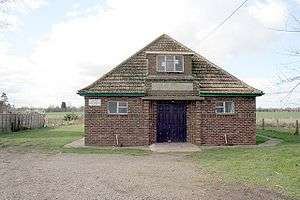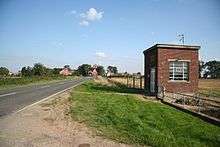Twenty, Lincolnshire
| Twenty | |
 The Village Hall, Twenty |
|
 Twenty |
|
| OS grid reference | TF153207 |
|---|---|
| – London | 90 mi (140 km) S |
| District | South Kesteven |
| Shire county | Lincolnshire |
| Region | East Midlands |
| Country | England |
| Sovereign state | United Kingdom |
| Post town | BOURNE |
| Postcode district | PE10 |
| Dialling code | 01778 |
| Police | Lincolnshire |
| Fire | Lincolnshire |
| Ambulance | East Midlands |
| EU Parliament | East Midlands |
|
|
Coordinates: 52°46′16″N 0°17′27″W / 52.7711°N 0.2909°W
Twenty hamlet in the South Kesteven district of Lincolnshire, England. It is situated approximately 3 miles (5 km) east from the market town of Bourne, and 5 miles (8 km) west from Spalding. Agriculture is the major industry.
Location
Twenty is situated on the A151 road, possibly originally a Roman road or Norman causeway, a road today notable for the very deep drainage dyke that runs alongside it. Nearby are Guthram Gowt and West Pinchbeck. Immediately to the south is the River Glen.
No separate population statistic is available for Twenty. The best available report lumps together Dyke, Twenty, South Fen and Spalding Road outside Bourne, with a total of 495,[1] with Dyke being the largest.
Twenty is surrounded by rich land reclaimed from wetland which was formerly fenland interspersed with marine creeks. It is part of the broad lowland, reclaimed from freshwater fen, marine marshland and creek levees, known as the Lincolnshire Fens. It is now some of the richest agricultural silt (marine) and black (freshwater) land in England, though the oxidation of the humus of the black soil has progressively exposed more of the clay derived from the underlying former salt marsh. When the Lindsey level was redrained after the 17th century Civil War, the new scheme was named the 'Black Sluice Level' after the sluice at Boston, through which it drained to the sea. Thus, Twenty stands in Bourne North Fen, which is the southern end of the Black Sluice Level.
The hamlet has never had a church or a chapel. The nearest would be at West Pinchbeck, Bourne or (in the 19th century) Dowsby Fen.
History
Medieval
According to a Peterborough monk's de Gestis Herwardi Saxonis, Bourne was the boyhood home of Hereward the Wake. With one or two exceptions, such as where two historical revolts are reported as one, the account can be verified to a surprising degree of probability by comparison with reports from other sources and by correlation of the account's geography with the likely reality in the English Fens and the southern Netherlands.
When he found that he might lose his inheritance, Hereward used the local terrain, fen and forest, to engage in a vigorous resistance to the Norman conquest. In the same year that Twenty's railway station opened (1866), the novelist Charles Kingsley published his romance Hereward, the Last of the English, in which he describes the Fens as he thought they had been in around 1070. His tale was a rewriting of the Peterborough monk's account, according to the taste of the 1860s. The Fens in general, though not around Twenty in particular, are also described in several modern novels, some of them about Hereward.
In 1138, Bourne was divided into two manors on the foundation of Bourne Abbey, (charter 1138). Some of the fenland, east of Bourne town, appears to have been allocated to each. The initial endowment of the abbey was made by Baldwin Fitzgilbert de Clare and his wife, but later legacies accumulated during the 12th, 13th and later centuries, though the abbey was never very wealthy. Possibly the Twenty area was acquired under the Abbott David from 1156, as fisheries in the 'Bourne marsh', though the connection of this with the site of the future Twenty is speculative. Limited information on how the Bourne fens were reclaimed in the period before 1630 is known. The abbey was governed by the Arrouaisian Rule, which had been derived from the Augustinian. The distinction became progressively less discernible over the years.
17th century
The Twenty Foot Drain was a main part of Robert Bertie, Earl of Lindsey's drainage scheme, declared complete in 1638 and undone from 1642 onward, during the First English Civil War (1642–46). The Earl died at Edge Hill (23 October 1642). The imposition of the Lindsey level is typical of the many local grievances which led to that war. The fenmen had their way until the 1765 Act of Parliament set the Black Sluice scheme into being. The drain was incorporated into this as a less important feature and persisted into the 20th century, though the length at Twenty is now filled in. Its name appears as "Old Twenty Foot Drain" alongside Twenty Drove, in plans in the Exeter Estate book of 1826/27.
In the Lindsey Level system, the Twenty Foot drain ran from south of the site of Twenty station (grid reference TF155197), two degrees west of north to Dowsby Fen. There (TF143290), it swept eastwards to drain to the estuary of the River Welland, nowadays at TF133316, by way of Gosberton High Fen, Risegate Eau and Bicker Haven. Its course can still easily be traced upstream from the former Dowsby Cross (which stood on the B1397 road where its line crosses the South Forty Foot Drain at TF162294 but it is not marked on modern maps), its course in the modern drainage pattern, is now fragmented.
19th and 20th centuries
Sugar beet (Beta vulgaris) production was first commercially developed in France, in response to the effect of the blockades on imports from the West Indies during the Revolutionary and Napoleonic Wars with Britain and other countries. Later, beet was raised in the reclaimed fenland east of Bourne, after trials elsewhere in England had proved unsuccessful. Although Britain's ravenous demand for sugar was mostly met by European beet and West Indian cane sugar imports until shortly after 1900, the successful sugar beet production in areas such as that around Twenty just met the nation's sugar requirements during the First and Second World Wars.
Twenty had a railway station from 1866 until its closure in 1959 when a large part of the local railway system was closed. The station's main apparent use was the removal to market of the produce of the black, humic soil which lay between Twenty and Bourne, as well as the less perishable products of the silt land.
The building style of the now demolished Twenty Farm made it appear to have been built just before the railway station opened. The 1892 Ordnance Survey shows that very little other domestic building had been added to the hamlet after 25 years. The remarkable feature is the administrative nature of the new buildings. To the farm and railway station had been added the police station and school and that was virtually all.
Twenty Foot Drain
The derivation of the name of Twenty has been much speculated about but it seems fairly clear that it arose from its position where, in the mid-19th century, the North Fen Drove crossed the 17th-century Twenty Foot Drain. By that stage, the road gave passage through to Spalding and had been turnpiked.
Roads and boundaries
It is probably unlikely that the A151 was a Roman road as during their times this area was either completely under water or at the very least a watery fen. More likely that the A151 was built during the drainage period or during enclosure of the local land. The Roman boundary was probably formed by the Car Dyke at a time when early land reclamation was in progress. Further land would have been claimed during the Saxon and medieval periods until the main land drainage schemes of the 17th century.
Modern drainage

The area falls within the drainage area of the Black Sluice Internal Drainage Board.[2] They maintain a small electric pumping station to the west of the crossroads, called Twenty Pumping Station
Landmarks
- Bourne Woods 6 miles (9.7 km) is 500 acres (2 km²) of woodland of primeval origin, though heavily exploited as a valuable resource for hundreds of years and largely replanted with conifers in the years around 1930. Nonetheless, much of the original flora remains and is now being nurtured by the removal of the conifers which are reaching commercial maturity. Features such as a sculpture trail and bike rides had already been introduced in recent decades. Bourne Woods form part of the 19-mile Bourne Cycle Trail.
- Baldock's Mill, the Heritage Centre, in South Street, Bourne, is open on weekend and public holiday afternoons and includes exhibits about local characters such as Hereward the Wake. It also features aspects of the town's past connections with motor racing, haute couture, the railway, agriculture and so on.
- Baston Fen nature reserve the southern banks of the River Glen to the west of Tongue End, are a nature reserve maintained by the Lincolnshire Wildlife Trust. Maintained as permanent pasture, it is flooded in winter to attract large numbers of wildfowl. There is an area of Willow Carr, flooded in winter, whose willows, osiers and alders provide nesting sites for birds, such as tits, finches and warblers.
- Thurlby Slipe nature reserve A similar band of wetland maintained by the trust on the northern bank of the Glen, famous for the variety of birds and butterflies.
- The Pinchbeck Engine includes a museum of land drainage, which is relevant to fen communities like Twenty and nearby Guthram Gowt.
- Ayscoughfee Hall in nearby Spalding contains a fine local museum, with details of the landscape before and after drainage, and with many artifacts showing what life was like in the fens in the past.
See also
References
- Wheeler, W.H. A History of the Fens of South Lincolnshire, 2nd edn. Boston & London. 1896. Facsimile edn Paul Watkins. Stamford. 1990. ISBN 1-871615-19-4 .
- Ordnance Survey. 1:25 000 First Series. Sheet TF12 (Dowsby). 1955.
- Croft, E. Lincolnshire Railway Stations. Reflections of a Bygone Age. Nottingham. 1993. ISBN 0-946245-77-0 . (a photo of Twenty Station).
- Dugdale, W. Imbanking and Draining. 1662. (Map of the Lindsey Level.)
- Bevis, T. Hereward and De Gestis Herwardi Saxonis Westrydale Press. March. 1981. (direct translation of the Peterborough monk's work).
- Sugar Beet: see Discovery and ulterior links.
- Sugar Beet: slightly fuller history in French: see Histoire and ulterior links (External links).
External links
 Media related to Twenty, Lincolnshire at Wikimedia Commons
Media related to Twenty, Lincolnshire at Wikimedia Commons- District Council page on Bourne
- Map sources for Twenty, Lincolnshire
- Lincolnshire Wildlife Trust